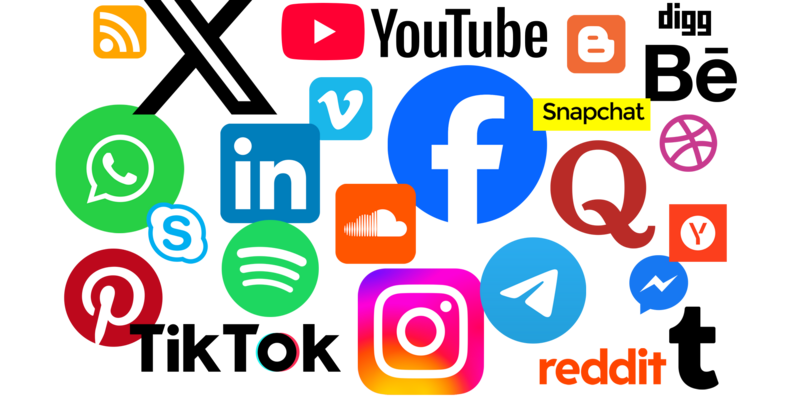Top Social Media Platforms Of 2025 (Ranked By Purpose)
In 2025, social media is more than just a place to connect; it’s a dynamic ecosystem where each platform serves a distinct purpose.
Whether it’s building a professional network, discovering fresh ideas, sharing short-form videos, or engaging in niche communities, today’s leading platforms have carved out specialized roles in the digital landscape.
This article examines the top social media platforms of 2025, ranked by the purpose they serve best. By focusing on their unique strengths rather than lumping them into a single category, we provide a clear, purpose-driven perspective that helps individuals, businesses, and creators choose the right platforms for their goals.
12 Best Social Media Platforms in 2025
| Platform | Best For | Quick Take |
| Professional Networking | A go-to hub for building careers, connecting with industry peers, and showcasing expertise. | |
| Inspiration & Visual Discovery | A digital mood board for ideas, DIY projects, recipes, and creative inspiration. | |
| Visual Storytelling & Short-Form Content | A polished space for photos, Reels, and personal branding. | |
| TikTok | Viral Short-Form Videos | The entertainment powerhouse fueling trends, challenges, and viral content. |
| YouTube | Long-Form & Educational Videos | The video library of the internet, from tutorials to deep dives. |
| Threads | Real-Time Text Conversations | Meta’s sleek answer to quick, casual text-based updates. |
| X | Real-Time News & Conversation | A live wire of trending topics, breaking news, and public debates. |
| Broad Community & Network Building | Still the largest digital town square for friends, groups, and events. | |
| Authentic Niche Conversations | The forum of the internet, where every topic has a passionate community. | |
| Snapchat | Ephemeral & AR-Driven Content | Disappearing messages meet creative lenses and filters. |
| Private Messaging & Business Communication | A secure and simple way to stay connected across the globe. | |
| Telegram | Secure & Large-Scale Group Messaging | Encrypted chats with advanced features for large communities. |
1. LinkedIn (Best for Professional Networking)
| Factor | Details |
| Founded In / Launch | Founded in December 2002, launched publicly on May 5, 2003 |
| Founders | Reid Hoffman, Allen Blue, Eric Ly, Konstantin Guericke, Jean-Luc Vaillant (and others) |
| Global Monthly Active Users (2025) | Approximately 1.15 billion |
| Revenue (2024) | Around US $16.37 billion |
LinkedIn is the world’s leading professional networking platform, designed to connect professionals, facilitate career development, and support business growth. Established in 2003, the platform has grown to encompass over 1.1 billion members globally, with more than 300 million active users each month.
Its audience consists primarily of working professionals, including 65 million decision-makers and 10 million C-suite executives, making it a central hub for business networking and recruitment.
Owned by Microsoft since 2016, LinkedIn serves as both a networking tool and a marketing channel, offering solutions for talent acquisition, brand building, and B2B outreach.
The platform’s ecosystem includes professional profiles, job postings, industry insights, and a robust content publishing system, allowing members to share expertise and engage with relevant audiences.
In 2024, LinkedIn generated approximately $16 billion in revenue, largely from advertising and talent solutions. Its continued growth underscores its role as a vital resource for businesses, recruiters, and professionals seeking to expand their networks, share knowledge, and advance their careers in an increasingly digital economy.
2. Pinterest (Best for Inspiration and Visual Discovery)
| Factor | Details |
| Founded In / Launch | Founded in 2009, launched in March 2010 |
| Founders | Ben Silbermann, Paul Sciarra, Evan Sharp |
| Global Monthly Active Users (2025) | Approximately 570 million |
| Revenue (2024) | ~$3.6 billion annually; Q4: $1.15 billion |
Pinterest positions itself as a premier image-driven discovery platform and visual inspiration hub. Since its launch in 2010, the platform has grown under the leadership of founders Ben Silbermann, Paul Sciarra, and Evan Sharp
By 2025, Pinterest engages approximately 570 million monthly active users, led by a predominantly female demographic (around 70%) and a significant share of Gen Z users (circa 42%), especially intrigued by lifestyle and brand discovery content.
Financial performance in 2024 was particularly strong, with total revenue reaching $3.6 billion and net income of $1.8 billion, buoyed by deferred tax advantages and robust monetization strategies. The platform delivered its first-ever billion-dollar quarterly revenue in Q4 2024 ($1.15 billion) while achieving record user growth.
Key to Pinterest’s momentum in 2025 has been its adoption of AI-powered advertising tools, namely, visual search and the Performance+ campaign suite, which have enhanced personalization and advertiser results.
This, coupled with strategic partnerships (e.g., Google, Amazon, Magnite) and expanding Gen Z engagement, has fueled both user and revenue expansion.
3. Instagram (Best for Visual Storytelling and Short-Form Content)
| Factor | Details |
| Founded In / Launch | Launched on October 6, 2010 |
| Founders | Kevin Systrom and Mike Krieger |
| Global Monthly Active Users (2025) | Approximately 2 billion MAUs |
| Revenue (2024) | Estimated at US $66.9 billion, accounting for about 40% of Meta’s total revenue |
Instagram emerged in October 2010, founded by Kevin Systrom and Mike Krieger. Over the past decade and a half, it has evolved into a global cornerstone among social platforms, now engaging around 2 billion monthly active users as of 2025.
From early feed-sharing and filters to its current role as a multi-dimensional media ecosystem, Instagram continually adapts to cultural shifts. It’s not just about sharing photos anymore; it’s about serving as a creative hub for brands, creators, and everyday users alike.
With features spanning stories, reels, direct messaging, and in-app shopping, the platform caters to a wide variety of content consumption behaviors.
On the financial front, Instagram has become a heavy lifter for its parent, Meta. In 2024 alone, it generated an estimated US $66.9 billion, representing approximately 40% of Meta’s total revenue. This highlights Instagram’s powerful monetization capabilities, driven primarily through advertising including feed promotions, stories, and increasingly, video-centric formats like Reels.
4. TikTok (Best for Viral Short-Form Videos)
| Factor | Details |
| Founded In / Launch | Launched in September 2016 by ByteDance (international rollout in 2017) |
| Founders | Developed by ByteDance, founded by Zhang Yiming (creator of Douyin/TikTok) |
| Global Monthly Active Users (2025) | Estimated at approximately 1.5 billion MAUs in 2025 |
| Revenue (2024) | The estimated total revenue of US$23 billion in 2024 |
TikTok has redefined the way social media users create and consume content. Built around short-form video, its algorithm curates a highly personalized feed that blends entertainment, education, trends, and niche interests with remarkable precision.
The platform’s design encourages rapid content discovery, making it easy for new creators to gain visibility and for viral trends to emerge overnight.
Its “For You Page” is central to the experience, offering an endless scroll of videos tailored to user behavior.
TikTok has also expanded beyond dance challenges and comedic skits to include tutorials, product reviews, live shopping, and branded content. This versatility has attracted not only individual creators but also businesses seeking to connect with audiences in authentic, engaging ways.
The platform’s in-app editing tools, sound library, and effects empower users to produce polished content without external resources.
With its combination of creativity, discoverability, and cultural influence, TikTok has become both a trendsetter and a marketing hub, influencing industries from music to fashion. Its unique blend of entertainment and community makes it one of the most impactful platforms in today’s social media ecosystem.
5. YouTube (Best for Long-Form and Educational Videos)
| Factor | Details |
| Founded In / Launch | Developed in early 2005; beta launched April 23, 2005, domain registered in February 2005 |
| Founders | Chad Hurley, Steve Chen, and Jawed Karim |
| Global Monthly Active Users (2025) | Roughly 2.7 billion |
| Revenue (2024) | Around US$36.1 billion |
YouTube, conceived in early 2005 by former PayPal employees Chad Hurley, Steve Chen, and Jawed Karim, quickly transformed from a startup into a global household name. Its original public beta launched in April that year, and the site has since become the leading video-sharing platform globally.
At its core, YouTube operates as the go-to destination for video content of every kind, from evergreen educational tutorials and music videos to real-time live streams and shorts.
Its intuitive interface, easy-to-use upload tools, and powerful recommendation engine have made it equally accessible to individual creators, brands, and media companies.
Beyond serving individual creators, YouTube has evolved into a vital distribution channel for television networks and legacy studios. It now functions as a hybrid of user-generated social media and premium media content, attracting audiences across all demographics.
From a business perspective, YouTube’s monetization model blends advertising with robust subscription services, such as YouTube Premium, Music, and YouTube TV. In 2024, the platform notched approximately $36.1 billion in revenue, reflecting not only its vast user base but also its cross-format monetization potential.
6. Threads (Best for Real-Time Text Conversations)
| Factor | Details |
| Founded In / Launch | Launched July 5, 2023 |
| Founders | Developed by Meta Platforms (initially overseen by Instagram’s leadership) |
| Global Monthly Active Users (2025) | Approximately 350 million as of August 2025 |
| Revenue (2024) | Estimated at around US$200 million, driven by early-stage monetization efforts |
Meta introduced Threads in July 2023 as a microblogging alternative to X, with seamless integration into Instagram designed to accelerate adoption. The strategy paid off: Threads reached 100 million users within its first five days, quickly becoming one of the fastest-growing apps in recent history.
Initially managed under Instagram’s leadership, Threads has continued to evolve. By August 2025, it will have established a standalone identity with approximately 350 million monthly active users. Its growth has been fueled by strategic feature introductions, such as custom feeds, post scheduling, and view counts, as well as tailored content recommendation systems.
From a business perspective, Threads entered monetization in 2024. Meta began testing targeted ads, introduced premium subscriptions, and conducted pilot revenue initiatives. These steps generated an estimated $200 million in revenue for the year.
As Threads shifts toward independence, enhanced leadership, and feature innovation, it continues to carve out its space in the microblogging landscape, balancing community engagement with strategic monetization.
7. X (Best for Real-Time News & Conversation)
| Factor | Details |
| Founded In / Launch | Launched in July 2006 as Twitter, rebranded to “X” by May 2024 |
| Founders | Jack Dorsey, Biz Stone, Noah Glass, Evan Williams |
| Global Monthly Active Users (2025) | Approximately 586–611 million MAUs |
| Revenue (2024) | Estimated at around US$3.14 billion |
Originating in July 2006 under the name Twitter, the platform has long been a cornerstone of real-time conversation, driven by short updates, trending topics, and live dialogue.
With roots tied to creators Jack Dorsey, Biz Stone, Noah Glass, and Evan Williams, it redefined how we consume breaking news, public opinion, and social commentary. Over time, its evolution transformed Twitter into a global broadcast stage before undergoing a full rebrand to “X” by mid-2024 to reflect an expanded ambition.
By 2025, despite controversies and leadership changes, X still holds a substantial user base estimated between 586 and 611 million monthly active users making it among the most pervasive social platforms worldwide. The platform continues to serve as a dynamic public town square, where news, politics, entertainment, and cultural moments converge in real time.
Financially, X remains heavily reliant on advertising, having generated around US$3.14 billion in revenue in 2024. This reflects both its continued monetization strength and the challenges posed by shifts in advertiser confidence and platform perception.
As X charts its future under the strategic ownership of Elon Musk and the AI-driven ambitions of xAIit remains a powerful, though contested, entity in global digital communication and media.
8. Facebook (Best for Broad Community & Network Building)
| Factor | Details |
| Founded In / Launch | Launched February 4, 2004 |
| Founders | Mark Zuckerberg, Eduardo Saverin, Andrew McCollum, Dustin Moskovitz, Chris Hughes |
| Global Monthly Active Users (2025) | Approximately 3.04 billion as of June 2025 |
| Revenue (2024) | Around US$164.5 billion |
Facebook remains the most expansive social network globally, with over 3 billion users engaging each month as of mid-2025. Since its modest beginnings in 2004 at Harvard, co-founded by Mark Zuckerberg alongside Eduardo Saverin, Andrew McCollum, Dustin Moskovitz, and Chris Hughes, the platform has evolved into the centerpiece of Meta’s ecosystem.
Today, Facebook plays a vital role in the daily lives of users across all demographics providing peer-to-peer interactions, community groups, marketplace transactions, live streams, and algorithmically curated content.
Its advertising infrastructure is deeply embedded across industries, enabling businesses of all sizes to reach highly targeted audiences. Facebook’s ability to support scalable engagement and commerce, coupled with seamless integration across Meta’s apps including Instagram, WhatsApp, and Messenger underscores its ongoing dominance.
Financially, in 2024, Facebook helped Meta achieve revenues totaling approximately $164.5 billion, with nearly all of this driven by advertising across its family of apps.
The platform’s longevity, monetization power, and adaptability especially leveraging AI enhancements across ad targeting and content formats ensure Facebook continues to serve as the strategic linchpin in today’s digital marketing and community-building landscape.
9. Reddit (Best for Authentic Niche Conversations)
| Factor | Details |
| Founded In / Launch | Founded in June 2005 by Steve Huffman and Alexis Ohanian |
| Founders | Steve Huffman and Alexis Ohanian |
| Global Monthly Active Users (2025) | Approximately 850 million, with over 91 million daily active users |
| Revenue (2024) | Around US$1.3 billion |
Reddit stands as a vibrant ecosystem of online communities united around interests, discussions, and shared passions. Launched in June 2005 by Steve Huffman and Alexis Ohanian, the platform rapidly became a digital destination known as “the front page of the Internet.”
At its core, Reddit enables users to create and participate in topic-specific forums, or “subreddits,” fostering a diverse and authentic environment. From breakout Ask-Me-Anything (IMA) sessions to niche hobbyist communities, Reddit thrives on depth and authenticity.
Even with a vast footprint of ~850 million monthly users and over 91 million engaging daily, Reddit’s strength lies in the quality of its communal interactions, not sheer scale.
In 2024, Reddit generated around $1.3 billion in revenue, primarily via targeted advertising. This marked a 62% increase over the prior year, highlighting the successful monetization of its engaged base.
Moreover, Reddit has demonstrated significant progress toward profitability. In Q4 alone, the platform posted strong revenue gains alongside high margins, showcasing its ability to balance growth with financial discipline.
10. Snapchat (Best for Ephemeral and AR-Driven Content)
| Factor | Details |
| Founded In / Launch | Launched in July 2011 as “Picaboo”, rebranded to Snapchat in September 2011 |
| Founders | Evan Spiegel, Bobby Murphy, and Reggie Brown |
| Global Monthly Active Users (2025) | Approximately 900 million MAUs |
| Revenue (2024) | Around US$4.61 billion in 2024 |
Snapchat emerged in 2011 from Stanford University under the names “Picaboo” and later “Snapchat,” created by Evan Spiegel, Bobby Murphy, and Reggie Brown. It revolutionized social media with its ephemerality photos and videos (“Snaps”) that vanish offering a more authentic and playful way to communicate.
Over time, Snapchat has evolved far beyond fleeting messages. It introduced features such as Stories compilations of Snaps lasting 24 hours and immersive AR Lenses, which remain iconic to its brand identity. These creative tools made Snapchat especially appealing to younger audiences and cemented its cultural cache.
In 2025, Snapchat’s reach has broadened significantly, boasting approximately 900 million monthly active users, achieving near-universal engagement across a globally distributed user base. On the financial side, the platform generated US$4.61 billion in revenue in 2024, reflecting robust monetization across ads, subscriptions, and AR-driven commerce.
Snapchat continues to stand out with its innovative content formats, user creativity, and youth-centric engagement. Its blend of visual, ephemeral communication and progressive monetization strategiesespecially in AR and short-form videoensures it remains a vital fixture in the social media ecosystem.
11. WhatsApp (Best for Private Messaging and Business Communication)
| Factor | Details |
| Founded In / Launch | Founded in February 2009 by Jan Koum and Brian Acton |
| Founders | Jan Koum and Brian Acton |
| Global Monthly Active Users (2025) | Approximately 2.95–3.14 billion MAUs |
| Revenue (2024) | Estimated US$1.8 billion |
WhatsApp, launched in February 2009 by Jan Koum and Brian Acton, has grown into the world’s most influential messaging platform. As of 2025, it serves nearly 3 billion users monthly, reflecting its pervasive global penetration.
Renowned for its ease of use, strong privacy features, and end-to-end encryption, WhatsApp facilitates personal and business communication across a variety of contextsfrom everyday chat to customer service and group engagement.
While WhatsApp’s direct revenue contribution has historically been modest, estimated at around $1.8 billion in 2024, its strategic significance is far greater. Market monetization focuses on high-value business tools such as the Business API, Click-to-WhatsApp ads, and emerging AI-powered features, all designed to uphold user privacy while unlocking commercial potential.
This platform’s combination of colossal scale, trust-driven design, and evolving monetization makes WhatsApp a critical component of the modern digital communication landscape.
12. Telegram (Best for Secure and Large-Scale Group Messaging)
| Factor | Details |
| Founded In / Launch | Founded in 2013 by Pavel and Nikolai Durov |
| Founders | Pavel Durov and his brother Nikolai Durov |
| Global Monthly Active Users (2025) | Approximately 1 billion MAUs as of March 2025 |
| Revenue (2024) | Revenue of approximately US$1.4 billion, with profit of ~$540 million |
Telegram has established itself as a robust, privacy-centric messaging platform since its founding in 2013 by Pavel and Nikolai Durov. As of March 2025, it achieved a major user milestone crossing 1 billion monthly active users, placing it among the world’s most widely used communication apps.
What distinguishes Telegram is its commitment to user autonomy and an expansive ecosystem. Serving a role both as a messaging app and a platform for content distribution, it hosts public channels, bot-driven automation, mini-app integrations, and features such as powerful encryption, large file transfers, and cloud-based syncing. Its architecture supports a lean
operating model, reportedly with a small core team managing vast infrastructure through partnerships and automation.
2024 was a pivotal year for Telegram; it turned its first annual profit, posting about $1.4 billion in revenue and $540 million in profit, driven by a mix of premium subscriptions, targeted ads within large public channels.
Conclusion
In 2025, social media is defined by specialization. Each platform excels in its unique role whether fostering professional connections, inspiring creativity, building communities, or delivering real-time conversations.
By understanding these distinctions, individuals and businesses can focus their efforts where they’ll have the greatest impact. The right platform isn’t about popularity alone, it’s about purpose. Back your decisions with data from trusted sources like Resourcera to ensure your social media strategy is built on solid insights.



































